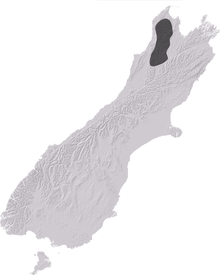Alpinacris crassicauda
Alpinacris crassicauda is a species of grasshopper only known from West Coast Region and Tasman Region, New Zealand. The genus Alpinacris is endemic to the South Island of New Zealand. A. crassicauda was described in 1967 by Robert Sidney Bigelow,[1] with a type locality of Lead Hills, Boulder Lake (40°53′35″S 172°32′56″E). A male holotype and paratype are deposited in the Canterbury Museum, Christchurch. Like all of New Zealand sub-alpine and alpine grasshoppers A. crassicauda has a 2 or 3 years life cycle. The eggs must ‘overwinter’ before they will hatch. Hoppers are found throughout the year and adult grasshoppers can be found throughout the New Zealand summer between December and April. The adult A. crassicauda do not overwinter.
| Alpinacris crassicauda | |
|---|---|
| Scientific classification | |
| Kingdom: | |
| Phylum: | |
| Class: | |
| Order: | |
| Family: | |
| Genus: | Alpinacris |
| Species: | A. crassicauda |
| Binomial name | |
| Alpinacris crassicauda Bigelow, 1967 [1] | |
 | |
| The distribution of A. crassicauda in New Zealand | |
Distribution and habitat
Alpinacris crassicauda is only known from West Coast Region and Tasman Region of New Zealand.[2] It can be found as far south as the Right Branch of the Rahu River, Spring Junction (42°17′31″S 172°07′24″E) and as far north as the Thousand Acres Plateau, Matiri Range (41°35′37″S 172°19′21″E). Alpinacris crassicauda prefer alpine tussock grasslands between 1,200–1,500 metres (3,900–4,900 ft), however, can be found as low as 1,020 metres (3,350 ft) on the Thousand Acres Plateau, Matiri Range (41°35′37″S 172°19′21″E).
Species description
The wings on A. tumidicauda are micropterous (small wings) between 2–4 millimetres (0.079–0.157 in) making this species flightless like most of New Zealand grasshoppers. Male body length 18–22 millimetres (0.71–0.87 in); Female body length 25–35 millimetres (0.98–1.38 in).
Type information
- Bigelow, R.S. 1967: The Grasshoppers of New Zealand, Their Taxonomy and Distribution. University of Canterbury, Christchurch.
- Type locality: Lead Hills, Boulder Lake, Tasman Region. 40°53′35″S 172°32′56″E
- Type specimen: Male; 27 October 1963; P. M. & M Johns. Holotype and Paratype are deposited in the Canterbury Museum, Christchurch.
References
| Wikimedia Commons has media related to Alpinacris crassicauda. |
| Wikispecies has information related to Alpinacris crassicauda |
- R. S. Bigelow (1967). The Grasshoppers of New Zealand, their Taxonomy and Distribution. Christchurch: University of Canterbury.
- Morris SJ. 2002. Distribution and Taxonomic status of New Zealand endangered grasshoppers (Orthoptera: Acrididae). Department of Conservation, Wellington.